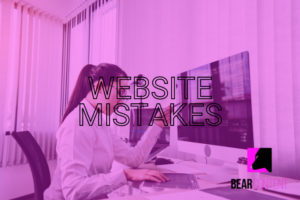As a business owner, you know that your website is one of your most valuable assets and fixing website issues should be on your list of priorities.
Your website is your business’s virtual home, where customers learn more about what you do and how to contact you.
It’s essential to ensure your website is working correctly and driving results.
But what are the top issues that are harming your website and your business?
This blog post will look at the five biggest website problems and how to fix them.
Let’s get started!
No SSL
Can I trust your website?
If you’ve not taken the simple step of correctly installing an SSL certificate, chances are your customers won’t even get as far as seeing your website.
Secure Sockets Layer (SSL) certificates are nothing new, available for use for more than twenty years.
Correctly installing an SSL certificate ensures that the sensitive data from all website visitors is transferred over a secure connection to your website.
Having an SSL certificate will improve the security of your website, protecting sensitive data transmitted to and from your site.
It also helps build credibility and trust with your customers. Your website will display a security padlock in the browser bar, indicating to visitors that your site is secure.
Some browsers now label those websites without an SSL certificate as ‘unsafe’, which could deter visitors before they even see your page.
From a search engine optimisation (SEO) perspective, secure sites are ranked higher than those missing a certificate.
If the s is missing from the HTTPS part of your website, or the padlock doesn’t display next to your website address in the browser bar, speak to your website developer or hosting company to resolve it immediately.
Default favicon
What’s a favicon when it’s at home?
Short for favourite icon, a favicon is a tiny image displayed next to the address of your website in the browser bar. It can also be shown as a bookmark icon or shortcut on a mobile phone.
Favicons matter because they brand your website and help with visitor recognition.
If your customers save your website in their favourites list, your favicon will help them quickly identify your site among a list of others.
So many websites today either don’t have a favicon or, worse still, display the default favicon from their website platform. Sites showing the default WordPress favicon are the most common.
First impressions count. Pay attention to detail and upload a custom favicon to your website.
Unsmushed images
Slow loading times are a significant factor in damaging the user experience for a visitor to your website.
Google looked into this and found that the bounce rate of websites (the percentage of visitors to a particular website who navigate away from the site after viewing only one page) rose 32% when the load time rose from one to three seconds.
Bounce rates rose 90% when the loading time increased from one to five seconds.
If you want visitors to stay on your website, you must make it speedy.
While there are many factors behind a fast website loading speed, compressing or ‘smushing’ your images is a significant element.
Smushing involves optimising images through a process known as lossless compression.
The image quality remains the same, but the image size is dramatically reduced, and the performance of your website is drastically improved.
If you’ve got a WordPress website, we love the SmushIt plugin. Simple and effective.
Out-of-date blog
When was the last time you updated your website’s blog, news or insights page?
If you have a blog on your site, you need to keep it updated.
Nothing says we don’t care about this website or its visitors than a blog section that was last updated several months earlier.
If you can’t commit to regularly adding new blog content, consider removing the blog from your website altogether.
Better still, create a content calendar and commit to adding new blog content weekly or fortnightly, engaging a third-party writer where necessary to help you keep up.
Broken links
Links on websites get broken for all sorts of reasons.
Perhaps the intended destination of a link no longer exists, or you mistyped the link address in the first place.
Whatever the reason, allowing broken links to remain on your website is terrible for business.
If your website visitors experience a broken link, it’s likely to sour their feelings towards your brand.
They also annoy Google (and other search engines), damaging your website’s authority rating.
There are various online tools out there to help you scan your website and find broken links.
Schedule a regular review of your site for broken links (monthly or quarterly) and fix them each time they are found.
At the same time, have an effective 404 ‘page not found’ page in place, using humour where appropriate.
That way, should your website visitors discover a broken link before you, they get something for their trouble.
***
First impressions are essential; your website is probably making a bad one if it’s doing anything on this list.
These website errors might seem small, but they add up to create a big problem for your business.
Don’t let simple mistakes hurt your bottom line – take the time to fix them now, and you’ll see a difference in your web traffic and sales.
Does your website have any of these issues? If so, what are you going to do to fix them?



